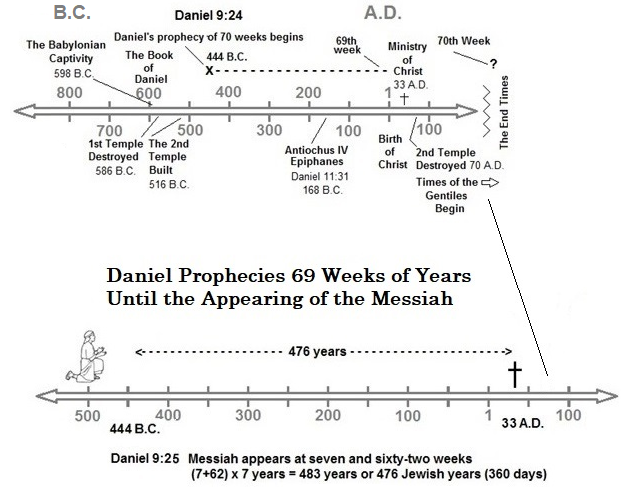
Set in the sixth century before Christ, the Book of Daniel in the Old Testament is essential in rightly understanding the Book of Revelation which closes the Bible in the New Testament. The Lord Jesus Christ himself references Daniel when speaking of His second coming, the false christs to come, and the “abomination of desolation” (antichrist) who will appear in the last days before this second appearing (Matthew 24:3-34). Daniel 9:24-26 sets the timeline of history into position with the prophecy of the seventy weeks.
What is a week?
First we must get something straight. Seven day weeks these are not. The term in Hebrew is sabbath meaning seven. This seven did not always mean literally seven days. In Genesis 29:27 Jacob does a bridal week to earn Rachael, Laban’s daughter. This required seven years of labor on Jacob’s part to earn her hand. If we need additional evidence we look at Daniel 12 where the second half of the week mentioned in Daniel 9:27 is played out in 1290 days which is equivalent to 3 1/2 years or half of the seven year sabbath week. With a starting date we will be ready to do some calculations.
Daniel 9:24 “Seventy weeks have been decreed for your people and your holy city, to finish the transgression, to make an end of sin, to make atonement for iniquity, to bring in everlasting righteousness, to seal up vision and prophecy and to anoint the most holy place.”
This timeline is given in three parts. Parts 1 and 2 are declared as seven plus sixty-two weeks for a total of sixty-nine weeks (sabbaths) of years. Part 3, the seventieth week will not be dealt with until in a whole new historical context revealed in Daniel 9:26 after the fall of Jerusalem and a subsequent history of war and desolation.
Part 3 is found in Daniel 9:27. And he will make a firm covenant with the many for one week, but in the middle of the week he will put a stop to sacrifice and grain offering…

Artaxerxes Decree
The decree of Daniel 9:24 to rebuild Jerusalem was made according to chapter 2 of Nehemiah in the 20th year of Artaxerxes reign. This would be 444 BC. Now 483 Jewish years are equivalent to 476 actual years. Therefore, if we move 476 actual years forward from 444 BC, we arrive at 32 A.D. or 33 A.D. if we correct for the absence of a year 0 A.D. This is the time of the appearance of Messiah or in the Greek, the Christ. Then, as Daniel also foretold, the Messiah would be cut off. Supplement Daniel with Isaiah 53 and we have what is known as Christ’s Crucifixion.
The Popular Messiah
The opinion of the Jewish clergy at the time was that the Messiah was supposed to deliver the Jews from their oppressors and usher in the Kingdom of God on earth as in Zechariah 14:2-4 when the Lord appears on the Mount of Olives and goes forth against the nations. The suffering servant Messiah of Isaiah 53 wasn’t the popular interpretation of scripture in that era. The Jews sought a messiah who would deliver them from their current troubles. Reconciling these competing versions of the coming messiah wasn’t at issue in those days. The victorious messiah was the default understanding. There were many scriptures supporting the view. Israel longed for a deliverer who would defeat their oppressors. At the same time, there were several sections of scripture that pointed to a suffering messiah. When week seventy finally arrives at the end of time there will be no doubt what kind of messiah is appearing.
Sidenote to History
There is an interesting side note to a likely reference in the Book of Daniel to the Book of Revelation’s announcement of the first four of the seals of the Book of Seven Seals of Revelation chapter 6. The breaking of these seals release those who are known as the Four Horsemen of the Apocalypse. They bring about war, plagues, and famine upon the earth. Daniel 9:26 reveals that after the Messiah is cut off, Jerusalem would be destroyed and then “even to the end there will be war; and desolations are determined.” This culminates in Daniel 9:27 with the abomination of desolation, known in New Testament as the antichrist, making a covenant with the Jews for seven years at the end of time. It is my contention, as well as a few others, that God did not leave the two millennia of history since Christ out of His final plan for the ages. This war and desolation in the ages following Christ is also spelled out in the Book of Revelation in the acts of these Four Horsemen. Many modern interpreters of scripture place all the acts of the Four Horsemen within the short period of seven years at the end of the Great Tribulation described by Christ while expounding on the Book of Daniel in Matthew 24:21. This argument will be challenged at a later point.
The Prophetic Week
Jewish years are calculated on a 29 or 30 day month. This results in a calendar about 11 days short of a solar year. The prophetic year is slightly different, derived from Revelation 11 and 13 where we find two periods of 1260 days. These periods cover the same events first prophesied in Daniel 9 and 12. The two 1260-day periods equal what’s referred to as a prophetic week of seven years. This computes as 7 years of 360 days each or 12 thirty-day months. Calculations of the appearance of Messiah are based on the prophetic year.